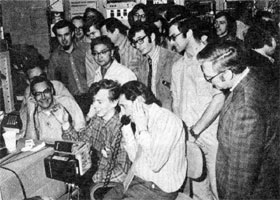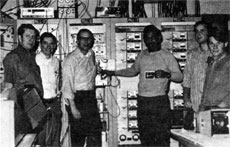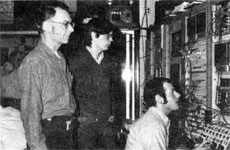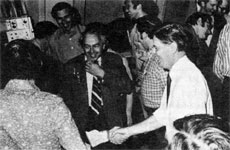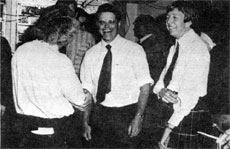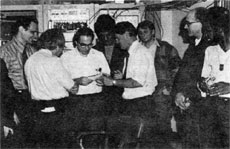NAL Accelerator Reaches Design Energy
At 1:08 p.m. on Wednesday, March 1, 1972 employees of the National Accelerator Laboratory opened the door to a new era of understanding of the world in which we live when the NAL accelerator system accelerated a beam of hydrogen protons to the design energy of 200 billion electron volts (BeV). Scientists from all over the world will use the beam to conduct a variety of experiments that will yield new knowledge of the characteristics and interactions of the particles of the atom.
The secrets uncovered will describe the "world of the small" with understanding that has been impossible without the NAL machine. Protons generated from hydrogen gas in a pre-accelerator moved in succession at increasing energy and intensity, through the linear accelerator, the booster synchrotron and finally into the Main Ring where they traveled around the 4-mile ring 70,000 times in 1.6 seconds receiving a 2.9 million electron volt boost of energy on each revolution until they attained an energy of 200 billion electron volts. Scientists using the machine accepted the challenge to explore the unknowns of the 1970's
The event touched off an all-Laboratory celebration, representing successful achievement of goals set years ago in which every employee without exception was in some way involved.
The 200 BeV level was one of a series of milestones since January 1, 1972 that saw acceleration rise from 20 BeV on January 22nd to 53 BeV on February 4th and to 100 BeV on February 11th. After reaching 100 BeV, a readjustment of 26 power supplies in the Main Ring enabled the machine to climb to 200 BeV. The delicate tuning, the horrendous assignment of getting the hundreds, the thousands of component parts of the huge machine to synchronize in absolute precision brought many moments of great frustration in the last days of February. The effort was typified by events on the afternoon and evening of February 29th when, after easily reaching 55 BeV, further progress was delayed for more than 12 hours because of magnet problems.
On the morning of March 1, at 9:30 a.m., Robert R. Wilson, Laboratory Director, reported to employees on his testimony the' previous day before the Joint Committee on Atomic Energy in Washington, D. C., the first of two days of hearings on budgets of high energy physics projects in the U. S. financed by the federal government. He expressed disappointment that he had not been able to report achievement of 200 BeV to the congressmen. Physicist Ernest Malamud reported to the group on the substantial progress made on the accelerator since reaching 100 BeV. Both men explained that although things were going very well, the elusive 200 was lurking just beyond the collective NAL fingertips. Dr. Wilson closed the meeting urging staff members to get the news the Joint Committee wanted. Within a few hours he was able to report to Washington that the accelerator had in fact reached its design level of acceleration.
After correcting the problems with the magnets early on the morning of March 1, the operations crew in the Main Control Room, with physicist Francis T. Cole as chief went into action about 8:30 a.m. Jim Griffin, physicist, stationed in the RF building, some six blocks away, turned on all RF stations. The intercom dialogue between Cole and Griffin began. The correction in the relation of the rate of rise of current between the bending and the quadrupole magnets was put into effect on the previous night shift by physicists Donald and Helen Edwards, who felt that this might have accounted for the beam instability after 30 BeV that had been encountered in the few days previously. Cole, Griffin, and other members of the crew spent the morning tuning and adjusting the machine to compensate for the most recent alterations.
At 11:00 a steady, stable beam was achieved. By 11:30 beam had passed transition energy (17.4 BeV). According to Ed Gray, synchrotron physicist on duty at the main control console, from then on things just got better and better. A slight jolt to the system - a "quad bump" - gave the beam further intensity. At 12:30 p.m. the beam reached 167 BeV for the first time. More and more people clustered around the screen in the Control Room lobby, watching the narrow band that typifies the beam as it crept slowly to the right to match the triangular peak representing 200 billion electron volts of energy. By 1:00 the screen was completely hidden by a crowd of forty or more people. The ding-ding-ding of a bell signaled the coming of the 200 BeV pulse in the bi-modal ramp.
At the RF building, Jim Griffin recalls, all controls were in ideal positions, but the noise of the gathering crowd in the Control Room drowned out the warning bell on the intercom; his adjustments had to be cautious. Stan Tawzer, working with Griffin, watched the screen. At 1:03, Tawzer noted, "That one went all the way out," but they waited for the next pulse to be sure. In the Control Room on the next pulse, someone in the hushed crowd said, "There it is!" and a rousing cheer filled the room at 1:08 pm!
On a desk in the lobby sat a carton with a white handwritten label reading, "For Ned Goldwasser...for 200 GeV celebration...from Al W... It's the correct brand. Tradition calls for 40 persons per bottle at lower energy machines...." Edwin L. Goldwasser, Deputy Director of the Laboratory, ordered the carton opened. The gift of chianti wine came a few days before from Al Wattenburg, professor of physics at the University of Illinois, who was one of the small group present at the first self-sustaining nuclear chain reaction achieved in 1942 by the team headed by Enrico Fermi, when a bottle of the same brand of chianti was passed among that group of pioneer nuclear scientists.
Now, thirty years later, another group of jubilant scientists shared a major achievement in particle physics. Dr. Wilson and Dr. Goldwasser passed through the crowd filling paper cups, shaking hands, accepting and extending congratulations at every turn. Later, champagne that had waited for many months in the cafeteria cooler, was served in plastic goblets labeled "200 GeV"!
The entire Laboratory joined the gala celebration. That evening the night crew held their own celebration. Everywhere it was recognized as a "team" victory. Each person on site felt he had contributed. Since breaking of ground for the linear accelerator on December 1, 1968, all efforts have been bent over the 200 BeV goal. The interim happenings - the linac 200 MeV beam on December 1, 1970; the booster 8 BeV beam on May 20, 1971; the first Main Ring beam on June 30, 1971 - all were important stepping stones on the way to the achievement.
The Main Ring shut down for a short period beginning March llth to install the water cooling system that enabled the machine to run regularly at 200 BeV and probably higher levels. The decision to go to higher levels depends somewhat on the results achieved at the 200 level.
The next major achievement of the staff was the extraction of beam from the Main Ring to the experimental areas. This highly technical effort was headed by physicist Edward Bleser. The first experimental area to receive beam was the 30-inch Bubble Chamber group. Meanwhile, Experiment 36 began in the Main Ring vacuum chamber, jointly involving experimenters from NAL, Rockefeller University, The University of Rochester, and the Institute for Nuclear Research in Dubna.


